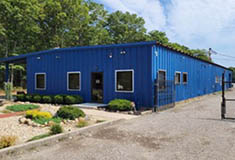News:
Long Island
Posted: October 21, 2008
Low vacancies and increasing rents dominate Long Island's industrial market
Unquestionably, Long Island's industrial real estate market is being challenged by today's economic conditions. The high costs of energy, bank failures, increasing inflation, and impending recession have taken their toll on manufacturers, distributors and other users of industrial space. Still, there have been some companies who, through smart business management and global opportunities, are experiencing growth and the need for larger industrial facilities. The resulting sales and leases, coupled with rising rents and lower vacancies have characterized the industrial markets in Nassau and Suffolk counties.
Noteworthy Developments and Transactions
Over the past several months, we've seen plans develop for Rechler Equity Partners' 53-acre Hampton Business and Technology Park located in Suffolk's Gabreski Airport in Westhampton Beach. Among its components will be a 50,000 s/f digital film studio. As a result of the entire park's development, which also will include a hotel and conference center, 600 to 700 jobs will be created.
Other significant industrial market developments in Suffolk include the pending $8 million sale of a 90,000 s/f building in Bohemia by Motorola to CMB Wireless.
One of the largest industrial leases signed during the second quarter of 2008 was for 167,718 s/f of space located at 100 Spence St. in Bay Shore by retail display manufacturer/distributor Summit Plastics Inc. Consumer Products Services also signed an impressive three-year term lease for a 109,000 s/f warehouse building. In Nassau County, Cox & Company is leasing 100,000 s/f at 1650 Old Country Rd. in Plainview.
Activity in Nassau County reflected the fact that it has a much lower industrial inventory than Suffolk.
Inventory Rates and Rents
Factoring in inventory across both counties, Long Island's industrial availability rate rose from 4.2% to 4.4% in the first quarter of 2008. An inventory of 305,560 s/f was added to the market. In this instance, Nassau, which recorded an unchanged industrial availability rate of 4%, fared better than Suffolk. Just 15,944 s/f of industrial space was absorbed in Nassau during the first quarter. By comparison, Suffolk recorded an increase in its availability rate from 4.2% to 4.6%.
The rent picture for each county reflected the supply situation. In Nassau, the average rent increased from $10.98 per s/f to $11.26 during the second quarter. Nassau saw an overall 7.4% increase in rents over last year. In Suffolk, the average rent decreased from $8.72 per s/f to $8.57 per s/f.
Going Green
One area casting a bright light on the market is the "green" initiative underway with many owners, managers and users of industrial and commercial real estate. Gyrodyne Co. of America, for instance, is in the process of retrofitting its 150,000 s/f building in St. James with daylight-sensing fluorescent lighting and switching to high energy efficient HVAC system. The property managers are also going green with their buildings. Racanelli Realty Services (Commack) recently installed a new energy-saving rooftop on one of its properties located at 780 Park Ave. in Huntington. According to independent studies conducted by Texas A&M, this measure will achieve up to 30-40% energy savings. New energy saving foam insulations are being applied in various buildings and even the landscapers are integrating plantings that can withstand drought conditions and promote a reduction in water and energy-consumption.
Further encouraging the wider adoption of energy-saving technologies and practices is the U.S. Green Building Council's (USGBC) Leadership in Energy and Environment Design (LEED) program. Properties that become LEED-certified are gaining attention from tenants who recognize the long-term energy savings attainable in buildings that meet LEED standards. In addition to having more marketable properties, the owners are also deriving cost-saving benefits. The USGBC conducted a study which found that buildings retrofitted for energy-efficiency can achieve an average of $.90 per square foot annually for their owners and a recovery of the retrofit project investment in less than three years.
A Strong Local Economy
While Long Island's economy is a reflection of the larger national picture, our region is still performing better than many areas across the nation. Our population of 2.7 million still can claim higher average salaries than the national average, a ranking among the top 12 regions in per capital income and, a ranking among the top 20 areas in total effective buying income at $73,149,028. Long Island's businesses are supported by countless economic development agencies from municipal Industrial Development Agencies (IDAs) to a workforce coalition, housing partnership and various business and trade associations. They are all working to effectively address market conditions challenging business' growth and expansion in the region.
Long Island's office market, which recorded a slight improvement during the second quarter of 2008, with 141,621 s/f of available space absorbed and asking rents increasing just slightly from $28.90 to $29.08, is further evidence of a strong local economy that performs even in the most challenging economic times.
However, the bailout of the banking system by the Feds and increased financial anxiety will be cause for pause in our growth. This will take a few months, if not more, to absorb and understand the process before we move forward.
Jack O'Connor is the principal and director - National Industrial Practice Group for Newmark Knight Frank, Melville, N.Y.
Tags:
Long Island
MORE FROM Long Island
Suffolk County IDA supports expansion of A&Z Pharmaceuticals
Hauppauge, NY The Suffolk County Industrial Development Agency (IDA) has granted preliminary approval of a financial incentive package that will assist a manufacturer in expanding its business by manufacturing more prescription (Rx) pharmaceuticals in addition to its existing over-the-counter

Columns and Thought Leadership

The evolving relationship of environmental consultants and the lending community - by Chuck Merritt
When Environmental Site Assessments (ESA) were first part of commercial real estate risk management, it was the lenders driving this requirement. When a borrower wanted a loan on a property, banks would utilize a list of “Approved Consultants” to order the report on both refinances and purchases.








.gif)
.jpg)